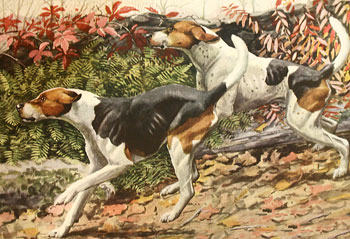
The English foxhound for more than 300 years has been one of the principle factors in the great English sport of fox-hunting. Perhaps no other single sport has done so much to mold the national character. The dogs in packs follow the fox across country, and the foxhunters, under the direction of a "master of foxhounds," ride after them.
The fine qualities developed by hard riding, by facing all kinds of weather, and by the dangers incident to jumping high fences and wide ditches, coupled with the sportsmanly behavior which constitutes the etiquette of the hunting field, were just the traits required to make gallant soldiers and successful colonists.
The English foxhound, while of ancient lineage and highly standardized in England, has not been found to meet exactly the requirements of the rougher sport in this country. This, through the efforts of a few assiduous foxhunters, there has been produced a somewhat rangier, lighter, and more courageous dog, known as the American foxhound.
The lighter build and more speedy American foxhound is used either in packs, followed by mounted hunters, as in England, or singly, or in couples, to drive the fox within rage of a gun.
The development of this breed has been largely due to the initiative and energy of a few men, notably Mr. Harry W. Smith, of Worcester, Massachusetts, in the North, and Brigadier General Roger D. Williams, of Lexington, Kentucky, in the South.
In essentials the American and English breeds are, of course, very similar. The English dog is a little squarer and more pointer-like in the head, with shorter ears and straighter, longer legs. Our dog seems more like a hound to us, with its fuller leather and more elastic pastern and hock and stifle. The English dog looks rather stiff and stilty in comparison, though undoubtedly just what the Englishman wants. And surely the English huntsman knows exactly what he wants.
The hound is a very primitive type of dog, and one of the proofs of this is his unvarying and rigid adherence to his pattern of color. White, of course, is not natural, but the result of ages of domestication, and may occur anywhere on a dog, as partial ablinism, without regard to symmetry or rule.
It will be found, however, that through all the ages nothing has been able to upset the fundamental pattern on all the hound-like dogs, which we see preserved in its purity in the black and tan bloodhound. White may supplant it anywhere, but if there is color it will invariably fall according to this design. Thus beagles, foxhounds, and many other dogs with hound blood in them will without exception have their black marks in the proper area for black to come, and their tan marks likewise, whether they come in large patches or as ticks or flecks of color in a white ground.
The drawings show the main characteristics of the two types, as well as their markings.




